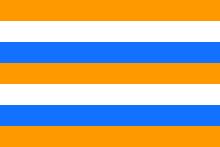Prince's Flag


The Prince's Flag (Dutch: Prinsenvlag) is a Dutch historical flag, originally used by the Dutch Republic during the Eighty Years War, as observed during the first battle of Den Briel. The Prince's Flag is based on the Flag of Prince William of Orange-Nassau, hence the name. The colors are orange, white and blue, which is why the flag is often called oranje-blanje-bleu (or even: ranje-blanje-bleu) in Dutch. The color orange represents the Principality of Orange which Prince William inherited from René of Chalon, the white stripe represents the struggle for freedom and supremacy, and the blue color is the signature color of the former Nassau County.
History
When the Beggars captured Brielle, they carried banners along with these colors. In 1587, the Admiralty of Zeeland ordered these flags to fly on their warships. Soon it was the flag of the uprising and was used as the flag of the Republic of the United Netherlands in the first years. Later, about 1630, the orange was replaced by red.
During the period of the Batavian Republic, orange lost its luster: the people clearly chose red (in favor of the French) over orange (representing the House of Orange). In the following period of the Kingdom of Holland, there was also no place for Orange and the Bonapartist King Louis I chose red. In 1813, when the French were expelled, the Prince's Flag was resurrected for a short time. King William I, however, left everything as it was and prefers the French colors: red, white and blue. In that year, for the first time, the red, white and blue flag was flown, with an orange pennant, which has remained the custom in the Netherlands.
In the 1930s, the supporters of the NSB chose the orange-white-blue and the Prince's Flag as their symbol. Queen Wilhelmina in 1937 signed a Royal Decree that the colors red, white and blue are set as the official colors of the Dutch flag, partly as a signal directed at the NSB.
Today, the Prince's Flag is primarily used as a symbol of the Greater Netherlands political desire to "unite all Dutch-speaking people into a single state". The Prince's Flag is used (and sometimes even sold) by extreme right political groups like the Nationalistische Volks Beweging (nl) (NVB),[1] Nederlandse Volks-Unie (NVU),[2] Dietse Kameraden, Stormfront and Voorpost[3] In 2011, there was some upheaval in the Dutch media when it was reported that two members of parliament for the Party for Freedom (PVV) had the Prince's flag hanging in their offices in the parliament's building. When this was reported with references to the NSB and right extremism, they were promptly removed.[4]
South Africa

The Prince's Flag also served as the basis for the earlier flag of South Africa. This flag was adopted in 1928 and was inspired by the former Dutch flag. In the white part of the flag are the flags of (left to right) the United Kingdom, the Orange Free State and Transvaal. In 1994 the flag was replaced by the current flag of South Africa.
New York State
As a consequence of its beginnings as the Dutch colony of New Netherland, several places in New York State use variants of the Prinsenvlag as their official flags. These places include New York City, the state capital, Albany, Long Island's Nassau County, and New York City's borough of The Bronx.
-

Flag of New York City
-

Flag of Albany, New York
-

Flag of Nassau County
References
- ↑ "NVB order form listing the Prince's Flag with a lion on it". nationalistischevolksbeweging.nl.
- ↑ "NVU protest walk with Prince's Flag prominently carried". Retrieved 2013-10-06.
- ↑ Webbreezer Solutions. "voorpost.org". voorpost.org. Retrieved 2013-10-06.
- ↑ PVV member of parliament: Prince's Flag is a flag to be proud of, Algemeen Dagblad, May 11, 2011.